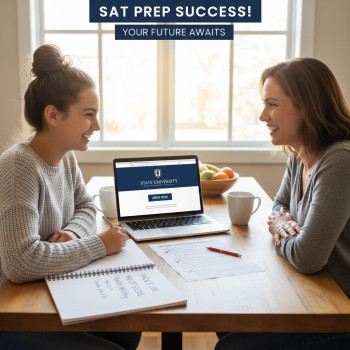Introduction: Why SAT Scores Still Matter for Liberal Arts Colleges
Take a breath. If you or your student are navigating liberal arts college applications with the Digital SAT in hand, the good news is this: scores are a tool, not a verdict. Many liberal arts colleges look at SAT scores as one of several signals—academic preparedness, fit, and potential to thrive in small-classroom settings. Used thoughtfully, SAT results help colleges make comparisons among many talented applicants and can unlock scholarship opportunities.
Below you’ll find a practical, step-by-step guide to understanding, interpreting, and using your Digital SAT scores to shape a strong liberal arts application—along with concrete examples, a sample timeline, and an easy-to-read score table. We’ll also touch on where personalized support, like Sparkl’s 1-on-1 guidance and tailored study plans, can help when you need it most.

Understanding the Digital SAT: What Changed and What Stayed the Same
The Digital SAT introduced a few format updates—shorter sections, adaptive question sets, and an on-screen testing experience—but its role in admissions remains similar: it’s a standardized measure colleges use alongside grades, essays, recommendations, and extracurriculars. Knowing the test’s mechanics helps you read your score report with confidence and choose application strategies that fit each college’s policies.
Key practical takeaways: the Digital SAT still reports scores that colleges can use for placement, scholarship consideration, and comparative evaluation. But remember: individual colleges set their own policies about whether and how they use scores.
Tip for parents: ask colleges directly about score use if you’re unsure—admissions offices can clarify whether they superscore, consider the highest section scores, or treat scores differently for scholarships.
What to look for on your Digital SAT score report
- Overall composite score and section scores—how they compare to the college’s reported range.
- Subscores and cross-test scores—these reveal strengths (e.g., evidence-based reading & writing vs. math).
- Percentiles—show how a score compares nationally.
- Timing and question-type breakdown—useful for targeted practice if you plan to retake.
How Liberal Arts Colleges Typically Use SAT Scores
Liberal arts colleges tend to focus on a holistic review: academic record, essays, recommendations, and fit in small, discussion-based classrooms. SAT scores are often supplementary—helpful for placement in first-year seminars, for scholarship eligibility, and for making admission decisions when academic records are otherwise similar. That said, policies vary: some schools are test-optional, others test-flexible, and many still welcome scores for scholarship consideration.
Because each college sets its own policy, the smart approach is individualized: map each school’s expectations and decide whether submitting a score strengthens the application.
When to submit your SAT scores
- Submit when your score is at or above the college’s middle 50% range—this strengthens your academic signal.
- Consider submitting if the score improves scholarship eligibility even when a school is test-optional.
- Skip submission if your score is well below a school’s typical range and you have stronger academic or extracurricular evidence to present.
Superscoring, Score Choice, and Strategic Sending
Three related ideas shape smart score use: superscoring (colleges combine your best section scores across test dates), Score Choice (you decide which test dates to send), and target sending (prioritizing schools where scores matter most). Not every liberal arts college superscores, so your strategy should be tailored.
How to build a sending strategy
- Make a list: categorize schools into safe, match, and reach using each college’s reported SAT ranges.
- Check superscoring and Score Choice policies for each college.
- If you improved in a later sitting, send the later score—or send multiple dates only to schools that superscore.
- If scholarships require a minimum, prioritize sending your qualifying scores to those schools.
Interpreting Score Ranges: Practical Examples
Imagine a student with a 1220 Digital SAT (combined) who’s applying to a liberal arts college where the middle 50% range is 1180–1350. That student is comfortably in the middle range and should consider submitting. Conversely, a student with a 1060 score applying to a college with a 1250–1400 range might opt not to submit, instead leaning into GPA, rigorous coursework, standout essays, and recommendations.
| Student Example | Digital SAT Score | College Middle 50% Range | Recommended Action |
|---|---|---|---|
| Alex, strong APs | 1420 | 1180–1350 | Submit (competitive; also aids scholarship) |
| Jordan, excellent essays | 1060 | 1250–1400 | Do not submit; highlight GPA and essays |
| Sofia, borderline GPA | 1230 | 1200–1320 | Submit; consider retake if scholarships require higher |
Putting Scores in Context: Essays, Recommendations, and Demonstrated Interest
For liberal arts colleges, personal essays and recommendation letters often tip the balance. If your SAT score doesn’t reflect your academic potential—perhaps due to test anxiety, limited access to prep, or a single off day—use essays and recommendations to provide context. A teacher’s letter that highlights class discussion leadership, intellectual curiosity, or research can be a powerful complement to a moderate SAT score.
Examples of contextual storytelling
- A student whose SAT math score is lower but whose math transcript shows A’s in advanced classes can ask a math teacher to emphasize growth and classroom performance.
- If a family faced disruptions (illness, job change), a brief mention in the application’s optional section can help admissions officers understand dips in scores or grades.
Scholarships and Placement: Where SATs Can Make the Biggest Difference
Even at test-optional colleges, SAT scores frequently factor into merit scholarship decisions and course placement (e.g., honors seminars or advanced math). If scholarship dollars are important, submitting a strong SAT score can unlock need-independent awards that make a liberal arts education more affordable.
Practical steps to maximize scholarship opportunities
- Research each college’s scholarship thresholds—some schools publish minimum SATs for certain awards.
- If you’re close to a scholarship cutoff, weigh a retake against investing in application elements like a stronger portfolio or essay.
- Consider targeted prep to raise specific subscores that matter for placement (e.g., math subscores for quantitative scholarships).
Retake or Not? Deciding Whether to Sit Again
Deciding whether to retake the Digital SAT depends on realistic potential for improvement and your application timeline. If you can add 50–100 points with focused study—and the extra score would open more matches or scholarships—it’s often worth a retake. If you’re pressed for time or scores are already in a school’s middle 50%, focus on essays and other parts of the application.
Checklist to decide on a retake
- Do you have a clear plan to add meaningful points (targeted practice, tutoring)?
- Is there a late enough test date that won’t interfere with application deadlines?
- Will a higher score affect scholarship eligibility or placement?
How to Improve Section-by-Section: Tactical Advice
Small, focused improvements in specific sections often beat unfocused studying. For example, boosting evidence-based reading by improving sentence-context strategies or increasing math fluency through daily targeted problem sets can add meaningful points.
Study micro-plans (2–6 weeks)
- Reading: Daily active reading (editorials, dense nonfiction) + 3 timed practice passages per week.
- Writing & Language: Weekly grammar drills focused on high-frequency error types.
- Math: Short daily problem sets emphasizing algebra and data analysis, plus one full timed math section per week.
Personalized, 1-on-1 tutoring—like Sparkl’s tailored study plans and expert tutors—can turbocharge this process by turning generic practice into targeted, high-impact work tailored to a student’s profile.
Timeline: When to Take the Test and Send Scores for Liberal Arts Applications
Timing matters. Many students take the SAT in the spring of junior year and again in the fall of senior year if they want to improve. This schedule gives time for substantive prep between attempts and still allows scores to be sent before early action/decision deadlines.
| Period | Activity | Why it helps |
|---|---|---|
| Spring junior year | First SAT attempt; baseline score | Gives time for focused improvement over summer |
| Summer | Targeted prep, possible tutoring | Build skills without school distractions |
| Fall senior year | Second attempt (if needed) | Finalize scores for early deadlines and scholarships |
| Oct–Nov senior year | Finalize applications, send scores to target schools | Align submission with scholarship and early decision deadlines |
Putting It All Together: A Sample Application Strategy
Meet Maya. She’s applying to five liberal arts colleges: two reaches, two matches, and one safety. Her Digital SAT is 1280, GPA is 3.7 with several AP classes, and she has strong extracurriculars in music. How should she proceed?
- For reaches (middle 50%: 1350–1500): Decide whether retaking could realistically add 50–100 points. If yes, retake in early fall; if no, focus on essays that highlight musical leadership.
- For matches (middle 50%: 1200–1350): Submit current score and highlight AP performance and recommendations that underline classroom engagement.
- For the safety school: Submit the score to strengthen scholarship eligibility and consider applying for departmental scholarships tied to music.
Strategically, Maya might work with a tutor or program that offers data-driven practice and personalized lesson plans. For example, Sparkl’s individualized tutoring and AI-driven insights can help target weak spots efficiently and turn that potential 50-point gain into reality.
How to Explain Scores in Your Application (When Appropriate)
If a score is significantly lower than your transcript suggests, a short, factual explanation in the application’s optional section can help. Focus on context (e.g., illness, family disruptions), actions taken since (retake plan, tutoring), and evidence of academic ability (class grades, projects).
Example concise explanation
“My March SAT score reflects a test day when I was recovering from a high fever. Since then, I retook practice tests and improved my math subscore by 70 points during self-study and targeted tutoring.”
Final Checklist Before Submitting Scores
- Confirm each college’s test policy (optional, flexible, required) and scholarship thresholds.
- If superscoring helps you, identify which colleges will combine section-best scores.
- Decide which test dates to send based on Score Choice and superscoring policies.
- Make sure your essays and recommendations reinforce what your scores cannot—character, curiosity, and fit.

Where Personalized Support Can Help
Every student’s situation is unique. If you’re deciding whether to retake the SAT or how to present scores to a liberal arts college, personalized tutoring and planning can make decisions clearer and more effective. One-on-one guidance—tailored study plans, an expert tutor who understands a student’s learning style, and AI-driven analytics that highlight the highest-return practice areas—can turn a scattered prep plan into a focused, results-oriented approach.
Programs like Sparkl emphasize individualized plans and expert tutors who help students target the exact question types and timing strategies that will most likely improve scores quickly. For families balancing schoolwork, activities, and test prep, that kind of targeted support can be the difference between a marginal and a meaningful score gain.
Parting Advice: Scores Are Important—but Not Everything
Liberal arts colleges seek students who will contribute to lively classroom discussion, bring curiosity and empathy to campus life, and take intellectual risks. SAT scores are an important data point, but they live alongside essays, recommendations, coursework, and demonstrated interests. Use your scores strategically—submit them when they strengthen your candidacy, explain them briefly when necessary, and invest time in the parts of the application that reveal who you are beyond numbers.
Quick summary
- Understand the Digital SAT score report and what your subscores reveal.
- Research each college’s score policy and scholarship thresholds.
- Use superscoring and Score Choice strategically.
- Retake only if realistic improvement is achievable before deadlines.
- Complement scores with compelling essays, recommendations, and evidence of passion and fit.
Ready to Plan Your Next Step?
Start by making a prioritized college list and mapping each school’s score-use policies and scholarship criteria. If targeted improvements would help, build a focused practice plan—short daily habits, weekly timed sections, and occasional 1-on-1 sessions to fix persistent problem areas. With a clear plan and the right support, SAT scores can open doors to the liberal arts experience that fits a student’s curiosity and growth.
And remember: thoughtful, personalized help can shorten the road. If tailored tutoring, data-driven practice, and one-on-one mentorship sound helpful, explore options that match your schedule and learning style—such as tutoring programs offering individualized lesson plans and expert feedback.
Final encouragement
This process can feel big—and it is—but it’s one chapter of a larger story. With preparation, honest self-assessment, and support when needed, students can use SAT scores to strengthen their applications while making sure the rest of their story shines even brighter.













No Comments
Leave a comment Cancel